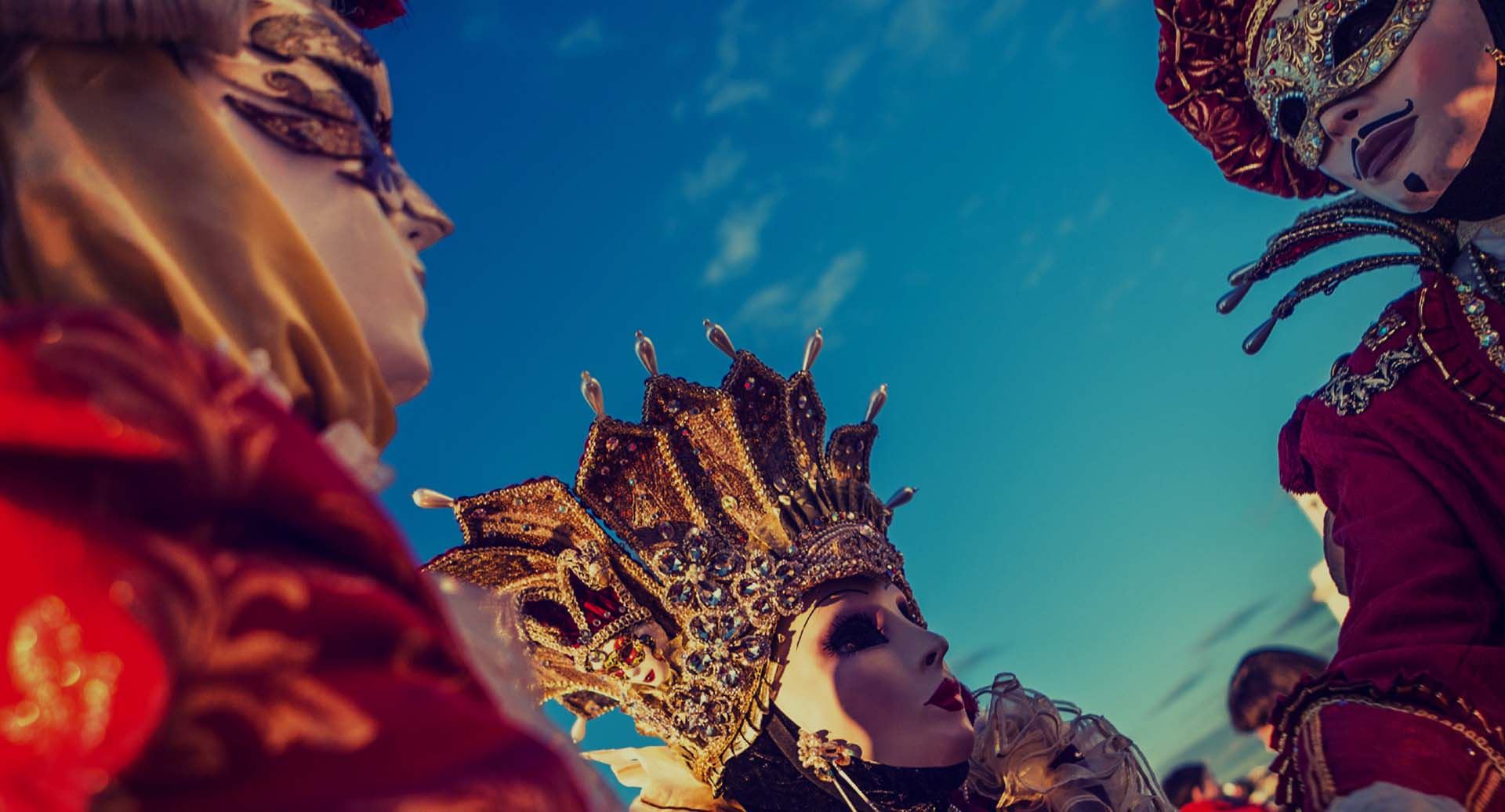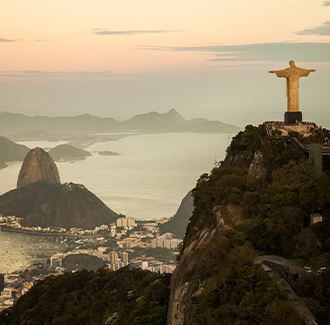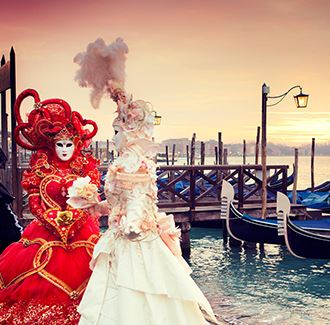Carnival Around The World
Among the many (and wise) Portuguese popular dictations, there’s one specially dedicated to this season, and that sums up the enthusiasm of the ones who celebrate it. We only have two days to live and the Carnival is three. And the truth is, when it’s about celebrating big time, the whole time in the world isn’t enough.
This “goodbye to the carnal pleasures” is announced by the arrival of the Lent, celebrated by Catholic Church. The origins of the celebration can be as remote as 600 years before Christ, in the Greek civilization.
Centuries after, catholic countries embraced the tradition and with the colonization, they carried it until such distant destinations as Brazil and Africa.
All over the world, the tradition stands steady, and has adapted itself to the country where it remains. In Brazil, Colombia, Italy or France, it will certainly be three days of festivity. And you better prepare yourself for everything: don’t forget that in Carnival, no one is taken seriously.
Rio de Janeiro: samba, sweat and Carnival
And we’re not talking about a simple celebration. Brazil is nowadays one of the most tolerant countries in the South America, and so, Rio de Janeiro is the perfect destination for you to give wings to your imagination and let loose of the prejudices. Relax and be very welcome to the “wonderful city”, also known as the “capital” of Carnival.
The celebrations before the Ash Wednesday are the result of one year of tuff preparations It officially starts with King Momo’s coronation: an amusing “maestro” that holds the key of the city as a symbol of the beginning of his reign.
Once you’re inside the party, it’s impossible to keep away from it. There are over 300 Carnival blocks that represent each neighbourhood, with different themes. From the most famous (and historical) ones, the highlight goes to Cordão do Bola Preta, Ipanema’s Band, Sovaco de Cristo that goes around the Botanical Garden and Carmelita’s Block that walks through Santa Teresa.
All the streets are closed to traffic and they are packed with people of all ages, colours and social classes. Professional dancers and participants shake their bodies at the rhythm of samba, a style of music invented by the afro-Brazilians at the beginning of the 20th Century.
If you want to watch all the shows, the Sambódromo holds 72 thousand people and even so, it’s better to buy the ticket early. You don’t believe it? Think about it: Rio’s Carnival is an attraction of over 500 thousand people every year.
Centuries after, catholic countries embraced the tradition and with the colonization, they carried it until such distant destinations as Brazil and Africa.
All over the world, the tradition stands steady, and has adapted itself to the country where it remains. In Brazil, Colombia, Italy or France, it will certainly be three days of festivity. And you better prepare yourself for everything: don’t forget that in Carnival, no one is taken seriously.
Rio de Janeiro: samba, sweat and Carnival
And we’re not talking about a simple celebration. Brazil is nowadays one of the most tolerant countries in the South America, and so, Rio de Janeiro is the perfect destination for you to give wings to your imagination and let loose of the prejudices. Relax and be very welcome to the “wonderful city”, also known as the “capital” of Carnival.
The celebrations before the Ash Wednesday are the result of one year of tuff preparations It officially starts with King Momo’s coronation: an amusing “maestro” that holds the key of the city as a symbol of the beginning of his reign.
Once you’re inside the party, it’s impossible to keep away from it. There are over 300 Carnival blocks that represent each neighbourhood, with different themes. From the most famous (and historical) ones, the highlight goes to Cordão do Bola Preta, Ipanema’s Band, Sovaco de Cristo that goes around the Botanical Garden and Carmelita’s Block that walks through Santa Teresa.
All the streets are closed to traffic and they are packed with people of all ages, colours and social classes. Professional dancers and participants shake their bodies at the rhythm of samba, a style of music invented by the afro-Brazilians at the beginning of the 20th Century.
If you want to watch all the shows, the Sambódromo holds 72 thousand people and even so, it’s better to buy the ticket early. You don’t believe it? Think about it: Rio’s Carnival is an attraction of over 500 thousand people every year.
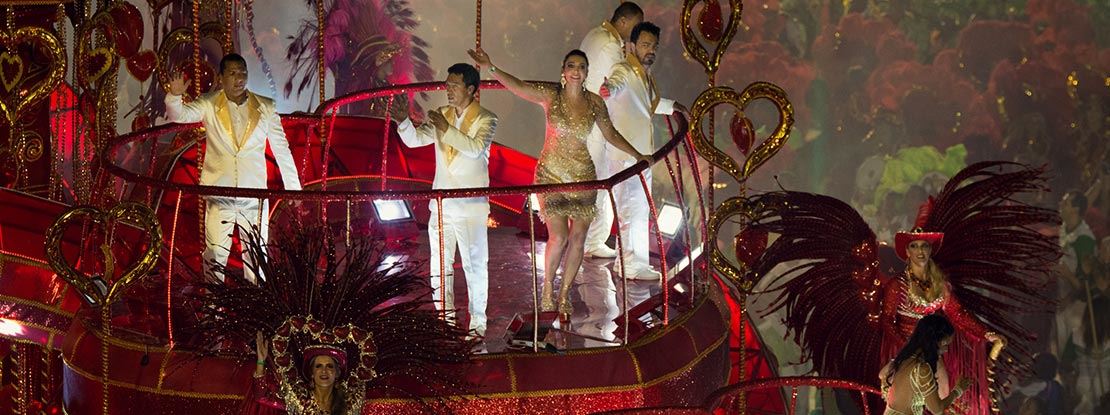
Bahia, the biggest explosion of joy”
The motto of Salvador’s Carnival is to be taken really seriously! Even more long that the one in Rio, the celebrations begin six days before the Ash Wednesday.
Did you know that here is the birthplace of the first electric trio? In 1950, Adolfo Dodô Nascimento and Osmar Alves created the “Fobica”, an old-fashioned car adapted to small itinerant concerts. Nowadays, huge cars with live musical performances are mandatory within the Bahian celebrations.
To watch the shows that pass along the Atlantic Avenue, you can rent a fix cabin or act like “popcorn” that joins the people dancing on the street. And for the locals, the dance is different from samba. The Axé is a mixture between Frevo and Afoxé, both with African roots, highly represented in the city.
The traditional tours for the parades are from Barra da Ondina / Dodô, Campos Grande / Osmar and Batatinha / Pelourinho, in the historical centre. If you want to avoid the parades but you want to listen all the musical performances, the neighbourhoods of Itapuã, Cajazeiras, Plataforma, Liberdade, Periperi and Boca do Rio get packed with well known artists and hot rhythms.
Puppets and Flowers
As in so many other cities, Carnival came to Nice as a justification to the people that used to have enormous feasts before the Lent’s arrival. The oldest mention of the celebration dates from 1294, when the Count Charles d’Anjou mentioned the “amazing days of celebration” there.
Centuries after, the good references remain. The modern manifestation of Carnival started in 1873 and the centre of the party is still Place Massena, the main square in the city.
Besides the parades of giant puppets, the Flower Battles are also famous here. Every year, at Promenade des Anglais, you can watch an epic battle of colours and smells, when millions of flowers are thrown from 16 cars to the people.
For the last celebration, the king of Carnival walks on the beach and you can listen people screaming, “Hail to the king! The king is dead!” And to celebrate in Nice, the throwing of confetti’s and serpentines is essential. You can buy them in every corner.
There are other festivals around if you’re willing to escape from the partygoers. Enjoy an escapade to Menton (30 minutes away from nice) where it’s celebrated the Lemon Festival, or even to Villefrance, a small village by the river where you can watch a smaller version of a Battle of the Flowers… inside the water.
The motto of Salvador’s Carnival is to be taken really seriously! Even more long that the one in Rio, the celebrations begin six days before the Ash Wednesday.
Did you know that here is the birthplace of the first electric trio? In 1950, Adolfo Dodô Nascimento and Osmar Alves created the “Fobica”, an old-fashioned car adapted to small itinerant concerts. Nowadays, huge cars with live musical performances are mandatory within the Bahian celebrations.
To watch the shows that pass along the Atlantic Avenue, you can rent a fix cabin or act like “popcorn” that joins the people dancing on the street. And for the locals, the dance is different from samba. The Axé is a mixture between Frevo and Afoxé, both with African roots, highly represented in the city.
The traditional tours for the parades are from Barra da Ondina / Dodô, Campos Grande / Osmar and Batatinha / Pelourinho, in the historical centre. If you want to avoid the parades but you want to listen all the musical performances, the neighbourhoods of Itapuã, Cajazeiras, Plataforma, Liberdade, Periperi and Boca do Rio get packed with well known artists and hot rhythms.
Puppets and Flowers
As in so many other cities, Carnival came to Nice as a justification to the people that used to have enormous feasts before the Lent’s arrival. The oldest mention of the celebration dates from 1294, when the Count Charles d’Anjou mentioned the “amazing days of celebration” there.
Centuries after, the good references remain. The modern manifestation of Carnival started in 1873 and the centre of the party is still Place Massena, the main square in the city.
Besides the parades of giant puppets, the Flower Battles are also famous here. Every year, at Promenade des Anglais, you can watch an epic battle of colours and smells, when millions of flowers are thrown from 16 cars to the people.
For the last celebration, the king of Carnival walks on the beach and you can listen people screaming, “Hail to the king! The king is dead!” And to celebrate in Nice, the throwing of confetti’s and serpentines is essential. You can buy them in every corner.
There are other festivals around if you’re willing to escape from the partygoers. Enjoy an escapade to Menton (30 minutes away from nice) where it’s celebrated the Lemon Festival, or even to Villefrance, a small village by the river where you can watch a smaller version of a Battle of the Flowers… inside the water.
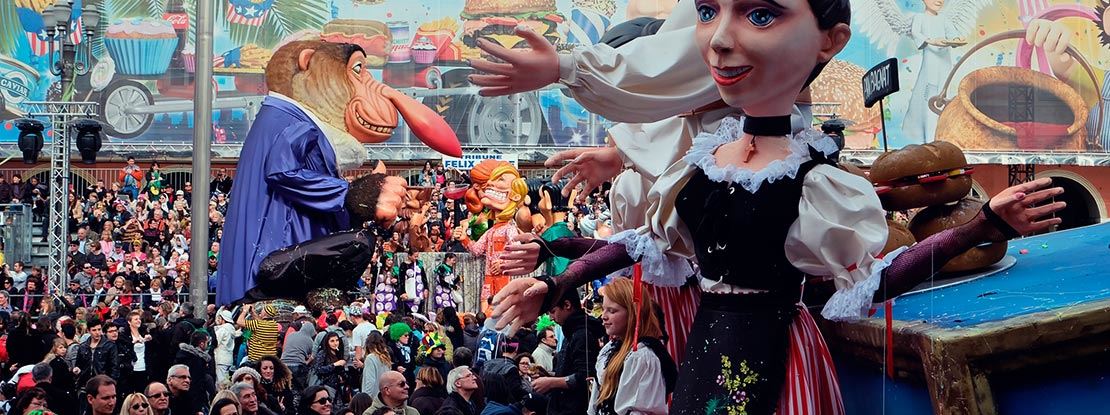
A party full of Illusions
Back to the cold in Europe, the idea of wearing a mask and a long velvet cloak in the Venetian Carnival sounds very useful… But the truth is that the wearing of the mask is way more theatrical and mysterious than you could imagine.
During the celebrations, nobles and people had permission to eat and drink without revealing their identity. Inside a rigid 17th Century hierarchic system, the wearing of a mask was the perfect excuse to celebrate without being afraid of the consequences. Even if you were a prince of a thief, nothing would matter to the occasion.
Very little was lost from the season’s theatrical ambience. The mask was kept and from the traditional white “barta”, to others much more bizarre as the “medico della pest” (the play doctor), it’s up to the partygoer to pick its own. The contest to chose the best mask it’s in March and it’ also a way to show around the best suits in São Marcos Square, where all the action happens.
The two weeks before the Lent start with the “Flight of the Angel”, when a girl wearing a mask climbs from the top of São Marcos Basilica, to the centre of the square. The party of the illusion has officially begun. Enjoy the escapade and get in the game.
Back to the cold in Europe, the idea of wearing a mask and a long velvet cloak in the Venetian Carnival sounds very useful… But the truth is that the wearing of the mask is way more theatrical and mysterious than you could imagine.
During the celebrations, nobles and people had permission to eat and drink without revealing their identity. Inside a rigid 17th Century hierarchic system, the wearing of a mask was the perfect excuse to celebrate without being afraid of the consequences. Even if you were a prince of a thief, nothing would matter to the occasion.
Very little was lost from the season’s theatrical ambience. The mask was kept and from the traditional white “barta”, to others much more bizarre as the “medico della pest” (the play doctor), it’s up to the partygoer to pick its own. The contest to chose the best mask it’s in March and it’ also a way to show around the best suits in São Marcos Square, where all the action happens.
The two weeks before the Lent start with the “Flight of the Angel”, when a girl wearing a mask climbs from the top of São Marcos Basilica, to the centre of the square. The party of the illusion has officially begun. Enjoy the escapade and get in the game.
Carnival of Blancos Y Negros
Colombia is one of the countries that received its tradition from Spain. North from the capital Bogotá, the first Barranquilla Carnival was celebrated over 100 years ago, when the city was very small.
Get ready to a real fusion between colours, races, beliefs and rhythms. From the indigenous’ descendants, to Spanish colons, Africans brought at slaves and immigrants, the mix of cultures resulted on an amazing party that celebrates the difference.
It starts four days before Wednesday and its climax is during the famous (and very colourful) Battle of the Flowers. In this parade, the spotlight goes to the King Momo, Maria Moñito, the Caimán Man, and the groups of dancers and masked ones, such as the marimondas and the gigantonas.
To end in big time, the symbolic death of Joselito Carnival marks the beginning of the Lent and the end of the celebrations. Little before his burial, at the 84 Parade, the Queen of the Carnival dresses all up in black and pretends to be the whippy widow of her dead husband.
But even in that case, Barranquilla’s motto is to be followed: “Quien lo vive, es quien lo goza”. The ones who live are the ones who can enjoy it and because of that, the show must go on until the burial, with dances and traditional Colombian rythyms such as cumbia, porro, mapale, gaita, chandé, fandango and puya.
Colombia is one of the countries that received its tradition from Spain. North from the capital Bogotá, the first Barranquilla Carnival was celebrated over 100 years ago, when the city was very small.
Get ready to a real fusion between colours, races, beliefs and rhythms. From the indigenous’ descendants, to Spanish colons, Africans brought at slaves and immigrants, the mix of cultures resulted on an amazing party that celebrates the difference.
It starts four days before Wednesday and its climax is during the famous (and very colourful) Battle of the Flowers. In this parade, the spotlight goes to the King Momo, Maria Moñito, the Caimán Man, and the groups of dancers and masked ones, such as the marimondas and the gigantonas.
To end in big time, the symbolic death of Joselito Carnival marks the beginning of the Lent and the end of the celebrations. Little before his burial, at the 84 Parade, the Queen of the Carnival dresses all up in black and pretends to be the whippy widow of her dead husband.
But even in that case, Barranquilla’s motto is to be followed: “Quien lo vive, es quien lo goza”. The ones who live are the ones who can enjoy it and because of that, the show must go on until the burial, with dances and traditional Colombian rythyms such as cumbia, porro, mapale, gaita, chandé, fandango and puya.
